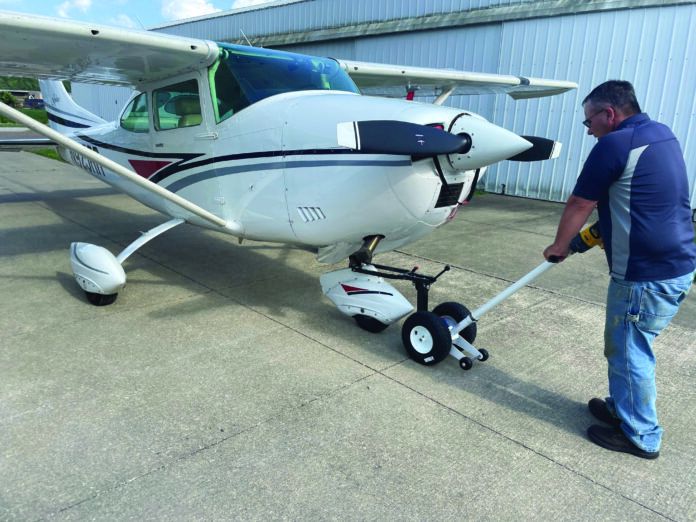Based on a field without line services (and refusing to move my Rockwell unassisted after slipping and falling while hand-towing it), I’ve been learning about the four broad-brush categories of hangar tugs. This includes more traditional aircraft-specific engine-powered tugs, electric-powered under-nosewheel/tailwheel tugs and handheld tow bars that use the kinetic energy of a spinning cordless drill.
Herewith are some top picks for drill-powered tow bars, with some tips for choosing one.
PRODUCT SELECTION
Like manual tow bars, powered ones aren’t perfect, and when shopping for an electric tow bar, consider traction when on snow and ice, the adapter that might be required for your aircraft model, battery endurance and replacement intervals, the tow bar’s speed, warranty, the potential shipping charges for in-warranty repairs and the return policy in case it doesn’t work for your application after trying it. That’s a lot to consider.
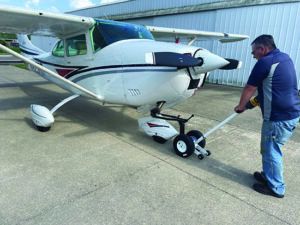
But these devices are lighter, more portable and less expensive than a powered tug. You’ll also want to consider the weight of the aircraft and any inclines that it needs to move on.
Minimax, Robotow, Redline and Innoquest have various models, based upon the maximum weight that they can accommodate. You might want to oversize slightly to ensure that you’re not overtaxing the drill.
BRING YOUR OWN DRILL
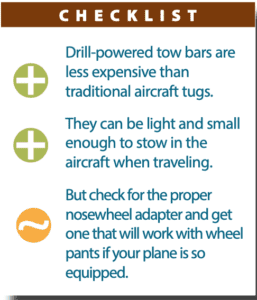
Simplifying the concept, these drill-powered tow bars are handheld tow bars that attach to the nosegear and a small drive drum that sits on top of the nosewheel tire. Power from a Milwaukee or DeWalt cordless drill (to name two) is transferred through a drive chain and down the pole to the drive drum, causing the tire to spin when the drill is activated.
Switching the drill to reverse simply causes the aircraft to roll to the rear. To change direction, just swing the tow bar either left or right. Since the drills are variable speed, it allows you to tow the aircraft at varying speeds. But there are some considerations, as I found on my airplane.
For the Commander 114, Minimax has a plate that is installed to the top of the nosegear fork onto which the tow bar attaches; many aircraft manufacturers use this standardized plate to attach traditional tow bars. Unfortunately, the Commander 114B doesn’t have the plate and the Robotow does not have an STC for its proprietary plate (requiring an FAA 337 form for U.S. registered aircraft).
ROBOTOW
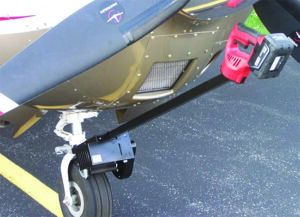
Ohio-based Aircraft Dynamics Corporation was founded in 1962 and makes the Robotow line. With 61 years of production, support and product development, Robotow is the thousand pound gorilla in the category. The Robotow comes in two models, including the $1765 24SL Cordless Robotow with a 24-volt sealed lead acid battery with 3-amp charger, plus the $1727 28VL Cordless Universal, with a 28-volt lithium-ion battery and charger. Aircraft towing adapters (and system freight charges—around $80) are extra.
The Robotow uses a black oxide-coated knurled drive drum that helps keep slipping to a minimum and drive torque to the maximum. The company offers a variety of adapters for Beech, Piper, Cessna, Cirrus (including the Vision Jet) and Mooney, to name a handful.
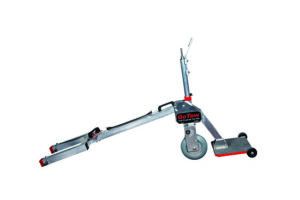
Robotow will sell you a replacement lithium-ion battery for $248 for their 28VL model; however, you can purchase a standard Milwaukee M28 battery (from a DIY store) to use as a spare or when it’s time to replace the battery. The 24SL Robopak Battery (lead acid) is $409. Note that this battery is not compatible with Robotows built before 2011. The company also offers battery chargers, plus the Dolly Wheel accessory. It’s made from PPG Durethane-coated steel and has hard rubber tires that attach to the Robotow frame using wing nut fasteners.
In field trials, the Robotow got high marks for portability, and it’s easy to load in and out of the airplane when traveling. Bill Rhoad, a Commander 115 owner, told us the Robotow tends to slow down in colder weather but that could be from an aging battery—something to keep in mind with any of these devices. The Robotow is available direct (www.robotow.com) or at Sporty’s and Aircraft Spruce.
MINIMAX
Its first product developed for the Beech Bonanza in 2012, Indiana-based Minimax Aircraft Tug offers four styles of tugs supporting 50 different aircraft—including taildraggers and helicopters. The focus is aircraft weighing less than 4000 pounds. Minimax electric tow bars are made (in the U.S.) from steel and alloy and use DeWalt electric drills, plus they have an enclosed oil bath transmission with an automatic brake intended for safer aircraft movement.
The aircraft attachment device comes pre-installed on the tow bar and purchasing the product has been simplified by Minimax through selecting your aircraft from a drop-down list on the company website.
As one example application, the Minimax electric tow bar for the Commander single weighs 25 pounds and has a simple knock-down design allowing it to be carried in the aircraft’s baggage area. Some newer Commanders have a tow plate installed on the nosegear fork, but for those that do not, Minimax sells a tow plate compatible with older models ($79.95), which might be installed by an A&P mechanic and signed off with an FAA 337 form.
The Minimax tugs typically retail starting at around $1899.95 and at press time the company was offering discounts up to $250. As an example, a “turnkey” setup for a Cirrus SR20/SR22 was listed at $2049 less a $250 discount. Additional products include an extended warranty, an extra 20-volt battery, a replacement drive chain and personalized N-number labeling. Worth mentioning is that depending on the aircraft model, Minimax has different models of tow bars at different price points and different discounts. Minimax uses either a DeWalt 20-volt or 60-volt drill for power, and based upon the specifics of the aircraft, the tow bar is equipped with the appropriate drill, gearbox and fork attachments. Some of the units have 13.5-inch tires and a single- or double-sided nosegear yoke, plus some models are available with a 60-volt power upgrade.
Consider that tire-driven tugs are more effective at pushing the aircraft, while pulling the plane uphill will require extra down pressure on the handle. As the Minimax (and other) tugs are lightweight, some down-force may be required to maintain tire traction while towing, especially when first getting the airplane rolling. Minimax says its tow bars, depending upon the model, will generally be able to move an aircraft 100 yards per battery charge, so consider having a few spare batteries on hand. Minimax offers a variety of options and spare parts. The product line is evolving for the light twin market with the recent addition of an electric tow bar to move a Beechcraft Baron. The company also offers an extended warranty (standard is one year) that’s $74.95 for an additional one year of coverage. Visit www.minimaxtugs.com.
REDLINE AVIATION
Redline is based in California and was founded in 2002, but started offering electric tow bars (it also sells non-powered tow bars) in 2008. Branded with red paint and using Milwaukee power drills, over 5000 units have been sold to date. There’s the $2650 Blade Runner and the $2050 Sidewinder.
Both the Sidewinder and Blade Runner are based upon the same tow bar chassis, but the Blade Runner includes a set of wheels allowing the operator to use the tow bar without lifting it. We heard from one Blade Runner owner who flies a Beechcraft Baron and she was not able to use other electric tow bars due to their weight. However, she can move the Blade Runner to and from the aircraft (it weighs roughly 22 pounds) unassisted. The tow bar, made from 4130 chromoly, easily stows in a baggage area because it collapses to a mere 27 inches.
The Sidewinder was originally designed for 4000- to 5000-pound aircraft, but the company said many owners are using them on much heavier models, including twin Cessnas, Piper Navajos, Daher TBMs and even Cessna Citation jets.
Each Sidewinder or Blade Runner includes the necessary fittings for a specific aircraft and is priced accordingly. Both models use a Milwaukee M28 drill (28-volt); however, Redline may be switching to Milwaukee’s F18 (18-volt) drill as Milwaukee may be discontinuing the M28. The Milwaukee drill and battery have a five-year warranty, while the Sidewinder and Blade Runner don’t have warranties at all.
“We don’t have a set warranty for the electric tow bars (except for the Milwaukee drills) because we’ve never had any problems or issues with the components we manufacture,” Redline’s founder told us. Interestingly, nearly three dozen pilots have started their Beech Bonanzas with a Sidewinder tow bar attached to the nosewheel, obviously doing damage to the device and the aircraft. Some pilots have even taken off with the Sidewinder attached, which are designed not to come detached from the nosegear. When retracting the landing gear, the nosegear obviously won’t go into the wells with the Sidewinder attached. Redline says that its electric tow bars don’t do we’ll in snow and ice because when snow and ice builds up on the tire, the roller will slip. Redline’s products can be purchased directly from the website (www.redlineaviation.com) or at supplier Aircraft Spruce.
INNOQUEST
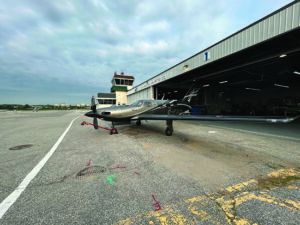
Woodstock, Illinois-based Innoquest began R&D efforts for an electric tow bar in 2016 (it first offered fuel testers) when its founder, Bill Hughes, needed a motorized tug for his Cirrus. After a review of the market he designed the GoTow and sent it to the market in 2019, where it currently retails for $2095. The approach is different than the competition in that the customer supplies the cordless drill—and stands on a 12- by 14-inch platform attached to the tow bar. This additional weight helps improve traction, while other designs require a downward force, potentially causing arm strain injuries. And to reduce the weight of the device itself, it’s made of aluminum. Moreover, Innoquest’s R&D efforts focused on developing a special type of gear train for the tow bar so that the drill’s brake is not activated when on a downslope. We think that’s smart.
Out of the box, the tow bar will fit most Cessna and Cirrus aircraft, and adapters are available for Piper (the Piper Tab Adapter is $95). And adapter kits for other aircraft, including Piper and Cessna retracs, Beech Bonanzas, Mooney M20s and Diamond DA20s and DA40s, are $125. The tow bar doesn’t ship with an electric drill, allowing the user to select the brand and model of cordless that they’re familiar with, potentially at better prices than Innoquest can offer. Plus, with no power tool included, Innoquest is not constrained by shipping lithium batteries.
The GoTow adjusts to fit most cordless drills (the required drill must be 18 volts or more) and it must have a half-inch chuck. The GoTow is limited to a maximum user weight of 270 pounds and maximum aircraft weight of 3500 pounds. The GoTow has a tow speed of 0.5 mph when powered by an 18-volt Milwaukee drill that’s spinning at 400 RPM. The tow bar weighs 28 pounds, not including the drill. “With cordless drill technology changing so rapidly and many pilots having aligned to a specific brand (with extra batteries), it made a lot of sense to design a solution which was drill agnostic,” Hughes told us. The GoTow can be purchased from Aircraft Spruce, Aero Phoenix and Sporty’s. Since Innoquest has no specific return policy, customers are left to work directly with the selling retailer. Visit www.innoquestinc.com.
TRY ‘EM IF YOU CAN
It’s hard to pick a favorite because there are so many variables that will make these electric tow bars work great or not we’ll at all. For one thing, the tow bar needs to have enough power to move the plane up inclines and over hangar door tracks and water rails. Some vendors have a 30-day money-back guarantee, assuming that the returned device is in pristine condition. Try it, first. Still, we know of owners who had to get creative by manufacturing small wooden or metal ramps to more easily guide the plane over the obstacles.
During our research, electric tow bar manufacturers noted that some owners get a running start to help get the plane over an obstacle. You might also angle the plane so that each main tire goes over the obstacle one at a time, if there’s room. This in itself shows that these drill-powered tow bars aren’t anywhere close to having the torque capability of a traditional aircraft tug. But we still think they can be a better solution than pushing and pulling the aircraft by hand. We’ll look at tugs in a follow-up article.

